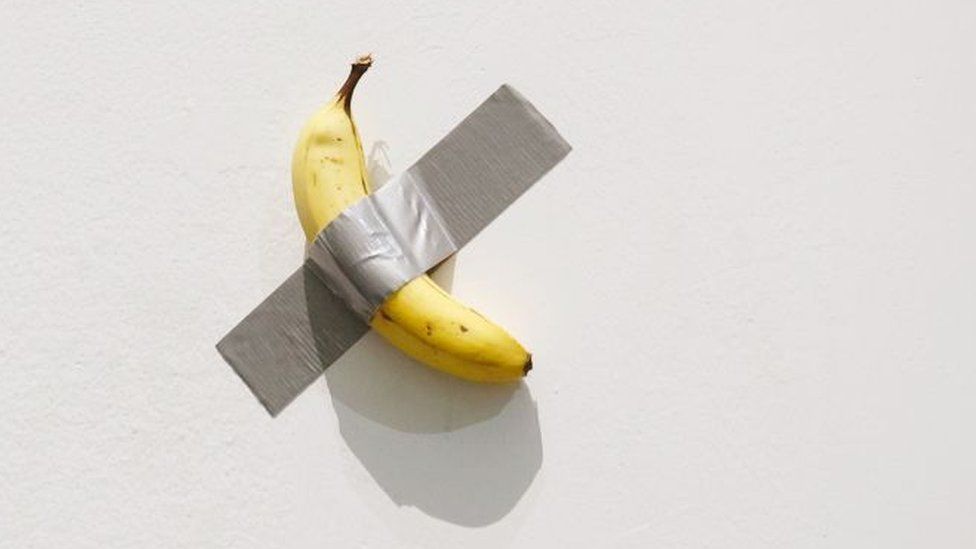Maurizio Cattelan's Banana Artwork Eaten By Hungry Seoul Museum Visitor
Maurizio Cattelan's banana artwork eaten by hungry Seoul museum visitor. The South Korean art student caused a stir at the Leeum Museum of Art in Seoul when he ate a banana that was part of an installation by artist Maurizio Cattelan. The artwork, titled "Comedian", consisted of a ripe banana duct-taped to a wall. The incident was captured on video and quickly spread on social media.
Author:Morgan MaverickReviewer:Raven NoirMay 02, 202317 Shares655 Views

Maurizio Cattelan's banana artwork eaten by hungry Seoul museum visitor. The South Korean art student caused a stir at the Leeum Museum of Art in Seoul when he ate a banana that was part of an installation by artist Maurizio Cattelan. The artwork, titled "Comedian", consisted of a ripe banana duct-taped to a wall. The incident was captured on video and quickly spread on social media.
Maurizio Cattelan's "Comedian" Banana Artwork Eaten By Hungry South Korean Student
The student, Noh Huyn-soo, later explained that he was hungry and had skipped breakfast that day. He reportedly saw Cattelan's work as a rebellion against authority and thought that damaging it could also be considered an artwork. "Isn't it taped there to be eaten?" he asked.
Video unavailable
This video is unavailable
The museum later replaced the banana with a new one, and according to local media, the banana on display is changed every two or three days. The museum did not respond to requests for comment, but it was reported that they will not be claiming damages against the student.
This is not the first time that bananas used in Cattelan's work have been eaten by visitors. In 2019, performance artist David Datuna removed a banana from the wall after the artwork was sold for $120,000 at Art Basel in Miami. The banana was replaced, and no further action was taken.
Maurizio Cattelan, known for his provocative and often humorous works, seemed unfazed by the incident. When told about the student's actions, he said, "No problem at all". In a statement, Cattelan's gallery, Perrotin, said, "The banana is supposed to be a banana".
The incident has sparked debate about the value of contemporary art and the role of museums in preserving it. Some argue that the student's actions were a form of artistic expression and that the museum should have embraced it. Others say that the artwork should be respected and preserved, regardless of its simplicity.
Quoting Noh Huyn-soo, he saw Cattelan's work as a rebellion against authority and thought that damaging it could also be considered an artwork. "Isn't it taped there to be eaten?" he asked. This statement suggests that the student was engaging in a form of artistic expression, perhaps as a commentary on the value of contemporary art or the role of museums in preserving it.
This incident also raises questions about the nature of contemporary art and its relationship to the viewer. Some argue that contemporary art is often inaccessible and elitist, and that incidents like this one help to break down barriers and make art more relatable. Others argue that the artwork should be respected and preserved, regardless of its simplicity or the viewer's personal opinions about it.
Conclusion
Overall, the incident at the Leeum Museum of Art highlights the complex and often contentious relationship between contemporary art, the viewer, and the museum. While some may see the student's actions as a form of artistic expression, others argue that the artwork should be respected and preserved, regardless of its simplicity.
Regardless of one's opinion, the incident has sparked an important conversation about the value and accessibility of contemporary art.

Morgan Maverick
Author
Morgan Maverick is an unorthodox news reporter driven by an insatiable hunger for the truth. Fearless and unconventional, he uncovers hidden narratives that lie beneath the surface, transforming each news piece into a masterpiece of gritty authenticity. With a dedication that goes beyond the boundaries of conventional journalism, Morgan fearlessly explores the fringes of society, giving voice to the marginalized and shedding light on the darkest corners.
His raw and unfiltered reporting style challenges established norms, capturing the essence of humanity in its rawest form. Morgan Maverick stands as a beacon of truth, fearlessly pushing boundaries and inspiring others to question, dig deeper, and recognize the transformative power of journalism.

Raven Noir
Reviewer
Raven Noir is a captivating and enigmatic news reporter who unravels mysteries with a relentless pursuit of truth. Possessing an insatiable curiosity and an astute mind, Raven delves into the depths of complex stories, unearthing secrets that lie beneath the surface. With a masterful grasp of deduction and observation, Raven stands as a beacon of fearless investigation.
In the realm of journalism, Raven is known for his enigmatic presence, drawing people in with an aura of intrigue. Driven by an unwavering passion for unveiling the truth, Raven Noir continues to shed light on the darkest corners of society. Through captivating storytelling and unwavering determination, he challenges conventions and uncovers enigmatic secrets that lie just beyond the surface.
Latest Articles
Popular Articles